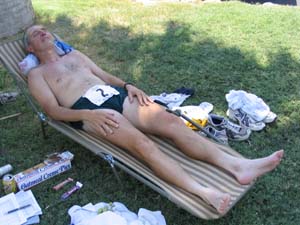The 2003 Badwater Ultramarathon Webcast

Jim Smith, runner #38, sits next to crew member Bob Johnson as he recovers. |
Dr. Lisa Stranc and RN Joyce Snobarger prep Chris for his IV. |
Dr. Stranc searching for a vein, which Chris' low blood pressure made difficult to find. |

Jay Birmingham cools off under the palms at Furnace Creek |
Ben Jones stretches out across his van. As Mayor, he can't help but wave to a constituent. |
Badwater From a Horizontal Perspective
By Greg Minter, July 23, 2003 7:56 AM
"I'm looking for a medic!" Don Meyer was shouting. "One of our crew passed out!" Team #38's truck wheeled around and Don and runner Jim Smith helped Bob Johnson into a fresh bed in the cool medical room. A great ultra-runner and previous Badwater finisher himself, Bob was experiencing what almost every ultrarunner has at one time another: seemingly inexplicable bonking.
"He passed out in the van," Don said. "Around mile 30, I was pacing Jim, and the van pulled up and Don started to throw up pretty violently. He said he was OK, so we continued on, but then the van pulled over and he was out. So we staked Jim's spot and boogied right down here."
Although he had regained consciousness by the time the vehicle had reached Stovepipe Wells at mile 42 of the race, the crew knew it was critical to get him cooled down immediately. The staff immediately began packing ice around Bob's neck, underarms, groin, and knees to bring his core temperature down. Joyce Snobarger, a registered nurse volunteering for the race, was quickly rounded up, then sat down with Bob, and immediately began to gather information and check temperature and vital signs.
After a short while, Bob started to come around, although he did continue to cramp in both his legs and hands. "He's really low on electrolytes," Joyce said. She gave him an electrolyte replacement and ordered him to continue eating the potato chips his crew were offering him. "If he's cramping that bad, it's obvious that he's pretty low on salt."
Both Mark Smith and his entire crew stayed in the room to make sure that Bob recovered. "I'm supposed to do a 250-mile run in Arizona on the 26th of August to raise money for the Parkinson's foundation," Bob said. Fortunately, once he cooled down, the medical staff pronounced him officially "OK."
Just Another Badwater Ultramarathon...
Although it might sound a little extreme, it's not unusual for either runners or crew to suffer from a variety of maladies, mostly heat related. Cramping, blisters, vomiting, heat exhaustion, and even heat stroke or heart problems are all potential dangers when passing through the most formidable environment in the contintental U.S.
The volunteer medical crew for the 2003 Kiehl's Badwater included Dr. Lisa Stranc, M.D. and husband David Bliss, registered nurse Joyce Snobarger and husband Marvin, plus Jeff Key, a certified CPR instructor. Each year leading up to the race, a series of "clinics" are held, and over the Memorial Day session, Jeff Key was pressed into duty, coming upon runner Gary Morris stretched out on the side of the hot asphalt road. He immediately began CPR, and Gary credits him with saving his life. "I'm extremely happy just to be here," Gary commented just moments before the start of the 2003 race. The fourth runner to compete the Badwater to Mt. Whitney crossing, back in 1983, Gary decided to watch this year's event, rather than participate, after his near-death experiece at the clinic.
So it is on the day of the race too. Runner #22 Chris Hendley was making a return visit and had come up with what he thought to be a good strategy. "We decided to do a 4 minute jog and a 4 minute walk, trying to keep a 12 minute pace. But I was getting hotter and couldn't regroup."
After a thorough review by Dr. Lisa, she recommended Chris take an IV, which, while medically necessary, also meant that he would be automatically disqualified from finishing the race. "We're having trouble even getting a vein on him, and his blood pressure is pretty low. But the IV will really do him a world of good."
Chris was philosophical about the day. "Two years ago, I did everything wrong and finished. I thought I had a good plan for today," he said, obviously disappointed. To distract him while the IV was being placed, I talked to Chris about what he did back home. "I'm a science teacher and cross-country coach at Western High School in Las Vegas, NV. I'll have to tell them it's always an experiment. Tell the kids I'm thinking of them."
On the Road Treatment
Although some work goes on in the medical rooms, a good deal of immediate care happens at the hands of the crew. Jay Birmingham, a pioneer runner, stretched out to cool off when he reached Furnace Creek, letting his crew douse him with cool water as he sat in the shade.
Further down the road, unofficial Badwater Mayor Ben Jones laid back in his crew van cooling off with ice packs. With a black trash bag taped across the van door as a piece of makeshift sun protection, Ben, a 3-time finisher was no doubt thinking about the daunting task that still lay ahead of him. His crew, which included three time Badwater finisher Rick Nawrocki, were doing everything to cool him down and make him comfortable. "We'll get him there. We just have to cool him down," said Rick.
Behind the Scenes
It takes a lot to put on the race, including lots of volunteers and lots of coordination. The orchestration is more jazz than symphony, and people need to be able to improvise depending on whatever situation arises. It's a great tradition at Badwater, and part of what builds the sense of family that permeates the participants, staff, crews, and even the communities that surround the race.